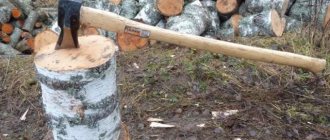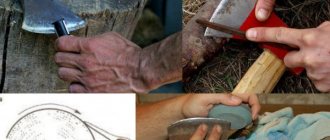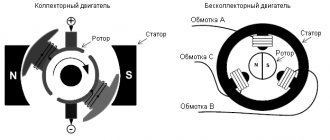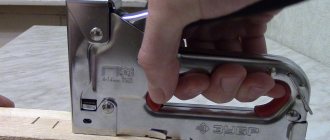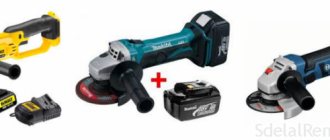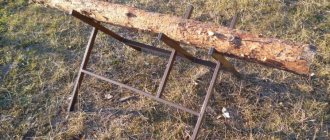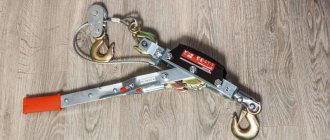Cleaver, its types, characteristics, recommendations for choosing this tool and rating of popular models.
Considering that the majority of the population of developed countries lives in cities, there are people who have no idea how firewood is collected for the winter.
In fact, in order to simply warm up the bathhouse, you need to prepare a decent amount of wood fuel, which is impossible with an ax.
And although there is an opinion that an ax is the main tool for preparing firewood, in fact it is intended for cutting down trees.
But the cleaver, the purpose of which is hidden in the name, is used to split logs and sawn tree trunks, turning them into logs in one movement.
Main characteristics
The cleaver is not an ax in the full sense, but it is directly related to it.
A hand tool has an ax handle on which a wedge-shaped working part (head) is mounted without sharp sharpening.
The cleaver is designed for a single blow, after which the log will split into pieces.
What is important here is not the sharpening of the blade, but the force of the blow.
Externally, the cleaver resembles more a sledgehammer than a classic axe.
One side of the head is flat (butt), and the opposite is wedge-shaped, made in the form of a double-sided cut at an angle of 40 - 50 degrees.
The weight of the cleaver reaches 5 kg, which allows it to cope even with large logs.
The meaning of this design lies not in cutting through the wood fibers, but in their delamination.
The thickness and length of the ax depends, first of all, on the size of the cleaver's head.
At the same time, the size of the handle directly affects the efficiency of work, since a long ax paired with a heavy head concentrates a decent impact force on a small area.
Blade
As already mentioned, the blade of the cleaver does not have a sharp edge.
Depending on the shape, wedge-shaped (wedge-shaped) and eared options are distinguished.
The second type, as the summer residents themselves note, is much inferior to the wedge-shaped ax in terms of ease of use.
It is noted that the head, due to the presence of “ears” set apart, often gets stuck in logs, after which it is difficult to remove.
The manufacturers themselves respond to this claim by saying that this design is designed to work with dry wood.
In reality, the owners of a private house use a tool to split raw, recently cut trunks, which is incorrect.
The piercing edge can be straight or rounded.
The first version of the cleaver is suitable for working with large dry logs.
The rounded blade has a larger size, which allows it to cope with resinous and damp wood.
The cleaver's head is made using the following methods:
• Stamping
Medium carbon steel is used.
In most cases, stamped cleavers weigh more than 2.5 kg, and their center of gravity is concentrated in the head. This allows you to use such a tool for working with large logs.
• Casting
The blade is made of hardened steel and is usually smaller in size compared to the option mentioned above.
They come in both straight and rounded.
Cast axes are more reminiscent of an axe.
Handle
The wooden ax handle is a classic.
It has always been used and will remain relevant for decades to come.
Unlike metal, wood has the beneficial property of absorbing shock and vibration.
In addition, wooden handles are relatively cheap and easy to manufacture.
All this affects the cost of the instrument for the better.
However, among the disadvantages it is worth noting the fact that the ax handle, if the technique of working with the cleaver is incorrect, splits.
An alternative to wood is fiberglass, a composite material with good strength properties.
Some models are produced with a rubberized handle, thereby increasing ease of use.
At the same time, it is lightweight, which allows you to shift the center of gravity of the instrument towards the head.
Fiberglass handle is a suitable solution for heavy cleavers.
A brief overview of the best cleavers
This rating of cleavers was compiled based on customer reviews.
FISKARS X27
FISKARS X27
This model deservedly leads, scoring 9.9 points at a price of 6-6.5 thousand rubles.
the combination of a low weight of 2.6 kg with a long, comfortable 80-centimeter handle makes it possible for even a not very strong but dexterous person to split complex logs. The best cleaver for splitting firewood will turn cutting wood from tedious work into fun.
MATRIX 21816
The Chinese-made budget model scored 9.7 points at a cost of 1500-2100 rubles.
The tool steel blade is securely mounted on the fiberglass handle. It is equipped with side projections that make it easier to split complex logs.
MATRIX 21816
A good ax belongs to the class of light cleavers - its weight is 2100 g. It requires frequent sharpening.
Heavy cleaver KRAFTOOL 20657-27
Designed for difficult working conditions and intense loads. The tool is used for wood of all species. At a price of 3400 rubles. he scored 9.2 points.
KRAFTOOL 20657-27
The particularly durable handle, reinforced with fiberglass, provides one of the highest strength and resistance to splitting, including at temperatures down to -40.
TRUPER MACH-18
8.7 points at a price of 930 rubles.
This is not a traditional cleaver, but a traditional Latin American heavy blade is also suitable for chopping wood for a campfire or barbecue. The machete has a heavy blade and a comfortable rubberized handle. There are teeth on the back of the blade; they can be used to cut down a small tree. Care must be taken when handling it.
Main types of cleavers
Hand cleavers can be divided into types depending on the size and shape of the head.
Modern instruments, due to their design features, can have several types of features at the same time:
Big cleaver
Large massive head and long handle.
Weight can reach 5kg.
Mini cleaver
It weighs from 1.5 kg and has a relatively short handle, up to 60 cm, which limits the scope of use of this tool.
Not suitable for working with large logs, and for thin branches it is preferable to use an ordinary ax.
“Iron”
A classic of domestic production.
A large tool with a hole for the handle located close to the butt.
Sledgehammer
A heavy tool designed for working with large logs.
The presence of a striking butt allows the tool to be used for driving in wedges.
Wedge-shaped
It has straight bevels and looks like a wedge.
Eared
Thin blade, like an ordinary axe.
At the same time, there are special “ears” on the head, designed to sharply expand the crack during an impact.
Chinese
The Chinese cleaver deserves special mention.
It is distinguished by a narrow nose, which, in fact, is a wedge with a handle.
It gets stuck into wood the first time, but often gets stuck tightly.
You can remove the head by hitting the butt on a log or by rocking.
As a result, you can observe a burst eye or a violation of the attachment of the ax to the cleaver.
Best all-purpose ax
Fiskars X10-S 1015619
This ax meets absolutely all the requirements of both a professional and an ordinary person. The ax and blade of this tool are perfectly balanced, which makes the work safe and convenient. With the help of such an ax you can tirelessly chop small trees, bushes and logs. And in moments of rest, the product is hung on a hook - this is what the hole at the end of the handle is intended for.
The ax handle of this model is made of hardened steel. This is partly what contributed to the strong increase in the price tag. But you will have to sharpen the product extremely rarely, if such a need ever arises. There is also an anti-friction coating, thanks to which you can work even in the rain - corrosion will not appear on the tool. The sharpening angle of the cutting edge is strictly 30. This ax can be praised for a very long time. Instead, we note that it is ideal for carpentry and joinery work. Only tourists will not like it - they will be shocked by its 440 mm length.
Read also: Rating of 5 kW electric generators
Advantages:
- The ax handle is made of hardened steel;
- Long and comfortable two-component handle;
- A hole for hanging is not forgotten;
- There is a Teflon coating;
- Optimal weight for use;
- The head is firmly fixed to the handle.
Flaws:
- Not everyone will like the price tag;
- It is not recommended to knock with the butt of the axe.
Rules for working as a cleaver
Having even the most expensive branded cleaver at hand, you will not be able to work effectively without experience.
However, at first, the following tips will help you cope with this problem to some extent:
• The widest log with a flat cutting area serves as a stand for logs. Installed in a stable vertical position.
• To make the work easier, you need to wait until the freshly sawn logs dry out. Otherwise, the wood will be viscous, and this will lead to jamming of the tool. In winter, it is better to let the raw material freeze. So it will become loose.
• For rational fuel consumption, it is better to chop the lumps into pieces with a diameter of about 10 cm.
• It may not be possible to split large logs in half the first time. To save time, it is better to chop off pieces along the edge and then cut the “core”.
• If there is a crack in the log, it is advisable to hit it with a cleaver. When working with knotty material, it is necessary to hit the tool either along one of the branches or between them.
• An old cleaver with a wooden handle must first be soaked in water. The ax handle at the junction with the head will swell and securely lock, preventing the metal part from falling off during operation.
• The handle of the tool always has an extension at its end. This is done so that the hands do not slip when struck. You should take the tool right at the extension in order to achieve maximum impact force using the lever.
A tool stuck in the deck can be removed in several ways:
• Loosen.
• Hit the butt with a sledgehammer, which will cause the wood to split.
• Swing the cleaver together with the block, turn the tool in the air and hit the butt on the log stand.
Due to the enormous impact force, working with a cleaver carries the risk of serious injury.
By following the simplest rules, you can significantly reduce or eliminate the risk:
• The block of wood must be placed on the edge of the deck on the far side. If you miss, the instrument will stick into the stand.
• You need to hold the cleaver by the edge of the handle, keeping your legs wide apart. Again, if you miss, the blade will go into the ground, not into your leg.
• To avoid shock absorption by the deck - stand, it must be installed on a hard surface (asphalt, concrete).
• The work area must be clear of foreign objects. It is better to immediately remove already split logs from under your feet.
• The presence of people in the immediate vicinity of the workplace is unacceptable, since wood chips flying in all directions are dangerous.
How to choose a cleaver
A cleaver is not a universal tool.
For this reason, there is simply no general advice on choosing the best model.
It is necessary to build on the shape of the blade, the length of the handle and the weight of the head.
The kinetics of the impact directly depends on them.
However, before you buy a specific cleaver you like, which in theory will perform the task, you need to check it for mechanical damage and absence of cracks.
The ax handle should sit tightly in the head; any play is unacceptable.
The handle should be comfortable and long enough, well polished.
Some models come with a case that will ensure safe storage and transportation of the tool.
It must cover the blade and sit securely.
Which ax to buy
1. If you are looking for a budget solution, we recommend choosing the IZHSTAL ax 030904-120. This is a carpentry tool that will help you cut down a tree and chop firewood. Also, purchasing it will allow you to support the domestic manufacturer.
2. The best carpenter's ax is Husqvarna 5769264-01. It is made from high-quality Swedish steel - even with regular work, straightening is required only once a year. The tool also features an excellent fit of the butt on the ergonomic handle. And only the price scares off the buyer.
3. The optimal choice for a carpenter should be MATRIX 21640. This ax is light in weight and has a fiberglass handle. For its price, this is an ideal tool. But for very frequent work it is better not to buy it - it is better to buy a heavier ax that speeds up the process.
4. If you are looking for a universal axe, then you won’t find anything better than the Fiskars X10-S 1015619. There is a two-component handle, and the blade was created from hardened steel coated with Teflon. As they say, buy it and forget it - the ax will never need sharpening.
5. MATRIX 21816 is an ax with a fairly long handle. Its weight is deliberately increased to make chopping wood easier. This is the task that the tool copes with best.
6. Tourists and ordinary lovers of hiking in the forest should buy Bison 20643-06 or STAYER “TOURIST” 2064-06. These axes are all-metal, which means they have an almost eternal service life. The rubberized handle facilitates comfortable use. These tools are the best way to gather firewood for your fire.
7. If you want to combine an ax and a hammer in one tool, we recommend paying attention to the Bahco 494-600. This hatchet is quite expensive. But it couldn’t have been any other way, because its creators had to work hard on the design. And an item that will not need replacement in the next decade cannot be cheap. Namely, this is the approximate service life of this ax.
Friends will also be interested in this
Do you want to receive up-to-date ratings and selection tips? Subscribe to our Telegram.
How to sharpen a cleaver correctly
The question of sharpening the blade of a cleaver ax remains open today.
Is it worth sharpening it at all?
The thickness of the blade, as a rule, does not exceed 5 mm over the entire surface, and experts advise using a floating sharpening (sharpness increases towards the center of the tool blade).
This will allow you to cope with wood of various species.
The sharpening angle also matters.
For most cleavers, the wedge is sharpened at an angle of 40 - 60 degrees.
At the same time, an angle that is too sharp is not suitable for working with soft and wet material.
The tool will get stuck in the fibers.
An obtuse angle is not suitable for frozen and dry logs, as the tool will simply bounce off.
The blade is sharpened with an electric sharpener at low speed.
Periodically, you need to moisten the wedge of the tool with water, which will prevent it from overheating during friction.
Vipukirves ax
Estimated price: $255
Opinion: The design of the ax is such that when struck, it rotates slightly, but with effort, along its axis, splitting the log without getting stuck in it. Professional woodcutters twist ordinary axes with their wrists, thereby achieving a similar effect, but for beginners Vipukirves will be a godsend.
What it's suitable for: Vipukirves are an ideal solution for splitting even logs of soft wood that does not offer much resistance.
Read also: Books on repairing welding inverters
How to properly store a cleaver
Storing a cleaver is no different from storing an ordinary axe.
Branded models are paired with plastic or leather cases, which allows you not only to store, but also to safely transport the instrument in a car or even public transport.
The metal part is coated with lubricant to prevent rust formation.
A tool with a large head can be safely coated with a thin layer of automotive oil.
For branded expensive models, a special lubricant for the ax is sold.
Tools with a wooden ax should not be stored in direct sunlight.
It is also not recommended to work in temperatures below -20.
It is best to store axes in rooms with average humidity.
